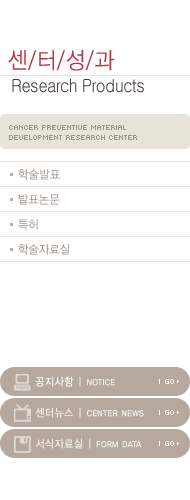 |
 |
 |
 |
|
 |
|
|
| Shikonin, Acetylshikonin, and Isobutyroylshikonin Inhibit VEGF-induced Angiogenesis and Suppress Tumor Growth in Lewis Lung Carcinoma-bearing Mice. |

 |
|
|
글쓴이 : 최고관리자
날짜 : 08-11-05 10:21
조회 : 1847
 |
|
 병리2008-13.pdf (619.3K), Down : 26, 2008-11-05 10:21:13 병리2008-13.pdf (619.3K), Down : 26, 2008-11-05 10:21:13 | |
Hyo-Jung LEE1), Hyo-Jeong LEE1), Venkataraman MAGESH1), Dongwoo NAM1), Eun-Ok LEE1), Kwang Seok AHN1), Min-Hyung JUNG2), Kyoo-Seok AHN1), Dae-Keun KIM4), Ji-Young KIM3) and Sung-Hoon KIM1)
1) Cancer Preventive Material Development Research Center, College of Oriental Medicine, Kyunghee University
2) College of Medicine, Kyunghee University
3) Graduate School of Biotechnology and Institute of Life Sciences and Resources, Kyunghee University
4) College of Pharmacy, Woosuk University
Abstracts
Lithospermum erythrorhizon has been used for treatment of inflammatory diseases and cancer as a folk remedy. Based on the evidences that anti-inflammatory agents frequently exert antiangiogenic activity, thus we examined comparatively the antiangiogenic activities of three naphthoquinone derivatives (shikonin, acetylshikonin, and isobutyroylshikonin) isolated from the plant. Three derivatives exhibited weak cytotoxicity against human umbilical vein endothelial cells (HUVECs) with IC50 of over 20 μM. Shikonin had more specific inhibitory effects on proliferation and vascular endothelial growth factor (VEGF) production by VEGF compared with different derivatives. All of derivatives significantly suppressed the migration of VEGF treated HUVECs at different optimal concentrations. Also, shikonin and acetylshikonin significantly disrupted VEGF-induced tube formation. Furthermore, three derivatives effectively downregulated the expression of urokinase-type plasminogen activator (uPA), but not its receptor uPAR. Additionally, shikonin significantly inhibited tumor growth in LLC-bearing mice, whereas its derivatives had relatively mild effects. Taken together, our findings suggest that shikonin and its derivatives exhibit the antiangiogenic and antitumorigenic effects by suppressing proliferation and angiogenic factors.
YAKUGAKU ZASSHI, Vol. 128 (2008) No. 11 pp.1681-1688
|
|
|
|
|
|




